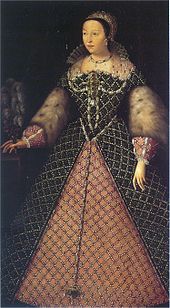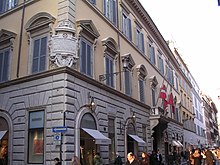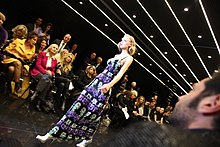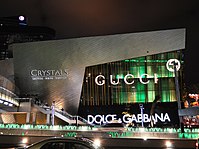Italian fashion
| Part of a series on the |
| Culture of Italy |
|---|
 |
| People |
| Traditions |
Italy is one of the leading countries in fashion design, alongside France and the United Kingdom. Fashion has always been an important part of the country's cultural life and society, and Italians are well known for their attention to dress; la bella figura, or good appearance, retains its traditional importance.
Italian fashion became prominent during the 11th to 16th centuries, when artistic development in Italy was at its peak. Cities such as
Italian fashion is linked to the most generalized concept of "
The nonprofit association that co-ordinates and promotes the development of Italian fashion is the
Italian fashion houses, designers and luxury brands
Examples of major Italian fashion houses focused on both menswear and womenswear, but also accessories:[6]
- Agnona
- Armani (founded and directed by Giorgio Armani)
- Balestra
- Bottega Veneta (designed by Belgian-French Matthieu Blazy)
- Roberto Cavalli (created by Fausto Puglisi)
- Costume National
- Brunello Cucinelli
- Diesel(directed by Glenn Martens)
- Dolce & Gabbana
- Dsquared2 (created by Canadian duo Dean and Dan Caten)
- Etro (directed by Marco De Vincenzo)
- Fendi (previously directed by Karl Lagerfeld for women's clothes and ready to wear and now by Kim Jones and by Silvia Venturini Fendi for accessories and men's lines)
- Ferragamo (designed by Maximilian Davis)
- Gianfranco Ferré
- Fiorucci
- Gucci (formerly directed by Tom Ford and by Alessandro Michele, now by Sabato De Sarno)
- Iceberg (directed by James Long)
- Jil Sander (founded by eponymous German designer but headquartered in Italy, designed by Luke and Lucy Meier)
- John Richmond
- Kiton
- Loro Piana
- Emilio Pucci (created by Camille Miceli)
- Marni (founded by Consuelo Castiglioniand now directed by Francesco Risso)
- Missoni
- Miu Miu (sister label of Prada founded by Miuccia Prada in 1992)
- Moncler
- Moschino
- Prada (Raf Simons joined Miuccia Prada as co-creative director)
- Ermanno Scervino
- Tod's (designed by Matteo Tamburini)
- Trussardi
- Valentino (founded by Valentino Garavani, formerly directed by Pierpaolo Piccioli)
- Versace (founded by Gianni Versace and now directed by Donatella Versace)
Examples of major fashion brands which are specialized mainly at womenswear (and also accessories for women) are
Luxury sportswear and
A few Italian designers head (or have headed) some important fashion brands outside Italy.
Among the newest labels or younger designers, the most prominent are
Other luxury labels which are mainly focused on the production of leather goods such as accessories, especially belts or shoes (but not only), are Anderson's, Aquazzura, Baldinini, Ballin, Bontoni, Casadei, Rene Caovilla, Bruno Magli, Paciotti, Pollini, Gianvito Rossi, Sergio Rossi, Giuseppe Zanotti, while fashion brands or labels which produce primarily bags, totes, suitcases are Braccialini, Furla, Mandarina Duck, Piquadro, Valextra.
Italy also is home to many fashion magazines, such as Vogue Italia, Vanity Fair, Elle, Glamour, Grazia.[7]
Other Italian accessory and jewelry brands, such as
-
Clothes byValentino
-
Giorgio Armani, founder of the Armani company
-
Prada shop in Milan.
Modern history

Fashion in Italy started to become the most fashionable in Europe since the 11th century, and powerful cities of the time, such as
After a decline in the 17th to mid-20th century, Italy returned to being a leading nation in fashion, and Florence was Italy's
.Today,
Cities
Italian fashion is dominated by Milan, Rome, and to a lesser extent, Florence, with the former two being included in the top 30 fashion capitals of the world.[14] Nonetheless, there are numerous other cities which play an important role in Italian fashion.
Milan
In 2014,
Florence

Rome

Other cities
Although Milan, Rome and Florence are commonly regarded as the leading cities in Italian fashion, other cities, such as
Fashion shows and fairs

The
References
- ^ "Nicole Kipar's late 17th century Clothing History - Baroque Costumes". Archived from the original on 2009-12-01. Retrieved 2010-01-06.
- ^ "The birth of italian fashion". Archived from the original on 2011-10-16. Retrieved 2011-10-21.
- ^ a b "The Global Language Monitor » Fashion". Archived from the original on 2009-11-01. Retrieved 2011-10-21.
- ^ You searched for fashion capital – The Global Language Monitor
- ^ Get to Know the Young Winners of the 2020 International Talent Support Awards - Vogue 28.10.2020.
- ^ "Italian Fashion: Designers and Brands - Made-In-Italy.com". www.made-in-italy.com. 5 January 2011. Archived from the original on 14 July 2012. Retrieved 15 October 2009.
- ^ "Italian Fashion, Beauty and Style Magazines". Made-In-Italy.com. 7 January 2011.
- ^ "ITALIAN FASHION >> Italian Fashion Tips | ITALIAN FASHION Guide!". Archived from the original on 2011-08-16. Retrieved 2011-10-21.
- ^ "WebMuseum: The Italian Renaissance (1420-1600)". www.ibiblio.org.
- ^ "HISTORY OF THE RENAISSANCE". www.historyworld.net.
- ^ "Italian Renaissance Fashion". www.renaissance-spell.com.
- ^ "Epoca n.95/1952" (PDF).
- ^ Fallaci – Mame Fashion Dictionary
- ^ "Archived copy". Archived from the original on 2012-05-14. Retrieved 2014-09-26.
{{cite web}}: CS1 maint: archived copy as title (link) - ^ "The Global Language Monitor » Fashion". Languagemonitor.com. 2011-08-20. Retrieved 2011-11-20.
- ^ "the birth of italian fashion". Gbgiorgini.it. Archived from the original on 16 October 2011. Retrieved 5 May 2009.
- ^ "Travel Guide to Florence". 11 November 2009. Archived from the original on 8 September 2017. Retrieved 26 November 2011.
- ^ "The Global Language Monitor » Fashion". Languagemonitor.com. 2009-07-20. Archived from the original on 2009-11-01. Retrieved 2009-10-17.
- ^ Patner, Josh (2006-02-26). "From Bags to Riches". The New York Times.
- ^ http://www.hoovers.com/company/Max_Mara_Fashion_Group_Srl/hksyhi-1.html [bare URL]
- ^ "Benetton Group - Corporate Website". www.benettongroup.com.
- ^ Limited, Mario Corporation. "Italian Fashion Wholesale clothing - apparel supplier in Italy". www.mariocorp.com.
- ^ "Italian brands distribution supply wholesale designer fashion luxury clothes - Italian Fashion buying house". www.italianbrandsdistribution.com.
- ^ "Milano Fashion Week: La Settimana della Moda che fa Tendenza!" (in Italian). 23 August 2018. Retrieved 8 January 2024.
- ^ List of Exhibitors accessed January 13, 2015
Further reading
- Martin, R. (1997). Gianni Versace. New York: The Metropolitan Museum of Art. ISBN 9780870998423.
- ISBN 978-8876675768), 230 pp.
External links
- Made-In-Italy.com Official Website
- 25 Best Italian Fashion Brands - Italy Best Official Website





